Free Vibrations Test Frame
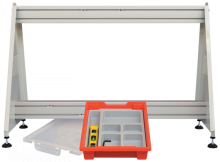
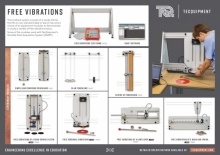
A sturdy bench top frame for use with the Free Vibrations experiment modules.
Experiment that uses the fundamental theory and Rayleigh's approximation to calculate the frequency of oscillation of a cantilever. It also utilizes Dunkerley's method to predict the 'beam only' frequency. Fits on to the Free Vibrations Test Frame.
This product is part of a range that explores free vibrations in simple ‘one degree of freedom’ systems.
A beam with the mass at the end works in a similar way to a mass spring system - the stiffness of the beam simply replaces the stiffness of the spring. However, in a mass spring system, we normally assume a ‘light’ spring compared to the mass. The vibrating cantilever examines what happens if the spring element (the beam in this case) is not light. Additionally, it examines a beam (with no tip mass) as a complete self-contained system, forming the mass and the spring.
The vibrating cantilever forms a simple and highly visual example of oscillations that may occur in real structures such as aircraft wings.
A back panel fixes to the Test Frame. The panel holds a sturdy clamp and two runners. The clamp holds the beam. Students use the clamp to adjust the oscillating length of the cantilever. The runners hold a non-contacting sensor that measures the oscillations at the end of the cantilever. The sensor has no physical contact with the beam, for negligible damping.
The back panel has a printed scale. Students use it to set the beam length accurately.
The product includes two beams; a plain beam and a beam with tip mass. Students may add extra ‘tip mass’ to the second beam to test how it affects oscillations. Students pull the end of the cantilever down and release, allowing it to vibrate. They then find the frequency of oscillation and compare it with that predicted from theory. Students test the beam with a varying tip mass, changing the ratio of tip mass to beam mass. They discover that for most ratios, the assumption that the beam is ‘light’ may not give accurate predictions of oscillation frequency. They then learn how Rayleigh’s method improves the overall prediction. They also use Dunkerley’s method to predict the natural frequency of the beam only, comparing this value with that found by other methods.
The back panel fixes in both horizontal and vertical direction to allow students to test the beams in both positions.
It introduces students to key scientific terms such as:
TecQuipment calibrate the displacement sensor to work with VDAS® (mkII) for real-time display and data acquisition of system oscillation wave-forms. Students use the software to see the displacement waveform and measure frequency. The software calculates and shows the first two derivatives of displacement - velocity and acceleration.
TecQuipment have specifically designed the TM166 to work with VDAS® (mkII). However, the sensor output may be connected to your own data acquisition system or oscilloscope if desired.
This product fits to the sturdy Test Frame (TM160) for study or demonstration.


A sturdy bench top frame for use with the Free Vibrations experiment modules.
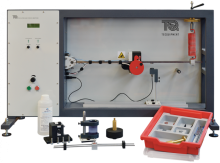
Benchtop apparatus that investigates the free and forced vibrations of a rigid beam with a spring, and a simply supported beam. Demonstrates Rayleigh's approximation and Dunkerley's method.
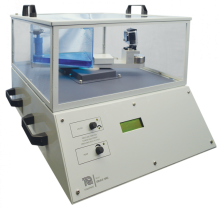
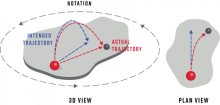
A highly visual demonstration of the Coriolis Force on a jet of water.
